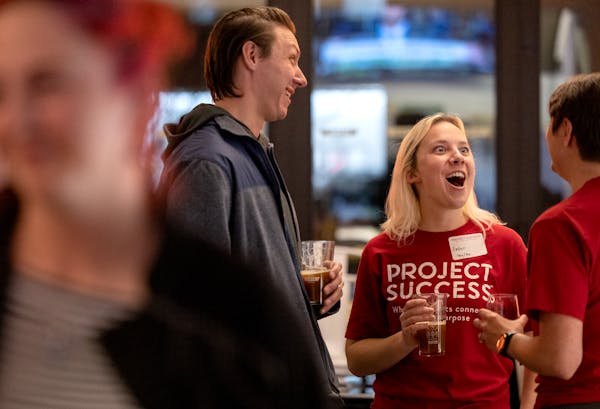Donors who don't have spare cash or coins will have a new digital option to give money to the Twin Cities Salvation Army this holiday season.
The Roseville-based nonprofit is testing out tap technology at about three dozen of its recognizable red kettles for its annual holiday fundraiser, making it easier for donors to give money with the tap of their credit card or smartphone.
"You just have to pull a card out, walk by and with a one-second tap, your gift has been made," said Paul Deakins, the organization's development director. "Anytime you can reduce the barriers for people to make a gift, that adds an opportunity."
The Salvation Army, one of the largest social service nonprofits in Minnesota, will kick off its annual red kettle campaign on Friday, collecting money in the red kettles stationed outside stores through Christmas Eve. About 10% of the Twin Cities kettles will have the special sensors that allow donors to tap it with a chipped credit or debit card or their smartphone to automatically give $5, $10 or $20 — technology that is increasingly available to consumers everywhere from the gas pump to the grocery check-out.
The nonprofit aims to raise $1.9 million at its nearly 300 red kettles in the Twin Cities, part of a broader year-end goal to raise $11.3 million — critical fundraising that usually ushers in more than two-thirds of the Salvation Army's annual revenue.
The organization has tried to make giving more convenient for donors, especially younger donors, by adding different pay options. In 2021, the Salvation Army started accepting donations over Venmo and PayPal after adding QR codes and bump pay options at red kettles. These allow donors to scan a code to get a link to their donation website or make a digital donation via Apple Pay or Google Pay.
All of those options are still available this year, but Deakins said QR codes force donors to fill out a form online to donate, which can be more cumbersome than the instant tap of a card or phone. Salvation Army chapters nationwide are testing out the new tap technology, and if it's successful in the Twin Cities, Deakins said the organization will expand the sensors to more kettles next year.
"The excuse, 'Sorry, I don't have any cash' doesn't work anymore," said Dan Furry, spokesman for the Salvation Army's Northern Division, which includes Minnesota and North Dakota.
Donors of all ages are giving more money online. A Giving USA report earlier this year found that millennials, Gen Xers and baby boomers give more money online now than in 2016 and have increased the average number of donations online. According to the report, 81% of millennials, 69% of Gen Xers and 61% of baby boomers give money online.
Charitable giving, though, has been on the decline after peaking at the start of the COVID-19 pandemic. Total giving by corporations, foundations and individuals nationwide dropped in 2022 for only the fourth time in four decades, according to the annual Giving USA report. Just among individuals, charitable giving plummeted 6.4% from 2021, with experts citing stagnant incomes, rising inflation and decreases in the stock market as some of the reasons for the lagging generosity.
As a result of decreasing donations, the Twin Cities Salvation Army has reduced its fundraising goals this year. While donations slip, expenses are still going up for the organization, as they are for many nonprofits. Deakins said the Salvation Army will either have to dip into reserves or scale back services if year-end fundraising efforts don't bring in enough donations.
The organization also relies on volunteers to stock food shelves, run its annual toy drive and ring bells outside the red kettles. Deakins said the organization started recruiting bell ringers earlier than normal this year to try to stem a volunteer shortage, but are seeing more corporations resume company volunteer efforts after slowing during the pandemic. To volunteer, go to RegisterToRing.com.
Brooklyn Park police make arrest after asking for help in search for man suspected of sexual assault at gunpoint

Attorney Tayler Rahm wins GOP backing in battleground Second District
North Oaks withdraws request for density exemption from Met Council



